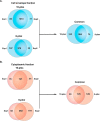Quantitative Proteomics of the 2016 WHO Neisseria gonorrhoeae Reference Strains Surveys Vaccine Candidates and Antimicrobial Resistance Determinants
- PMID: 30352803
- PMCID: PMC6317477
- DOI: 10.1074/mcp.RA118.001125
Quantitative Proteomics of the 2016 WHO Neisseria gonorrhoeae Reference Strains Surveys Vaccine Candidates and Antimicrobial Resistance Determinants
Abstract
The sexually transmitted disease gonorrhea (causative agent: Neisseria gonorrhoeae) remains an urgent public health threat globally because of its reproductive health repercussions, high incidence, widespread antimicrobial resistance (AMR), and absence of a vaccine. To mine gonorrhea antigens and enhance our understanding of gonococcal AMR at the proteome level, we performed the first large-scale proteomic profiling of a diverse panel (n = 15) of gonococcal strains, including the 2016 World Health Organization (WHO) reference strains. These strains show all existing AMR profiles - established through phenotypic characterization and reference genome publication - and are intended for quality assurance in laboratory investigations. Herein, these isolates were subjected to subcellular fractionation and labeling with tandem mass tags coupled to mass spectrometry and multi-combinatorial bioinformatics. Our analyses detected 904 and 723 common proteins in cell envelope and cytoplasmic subproteomes, respectively. We identified nine novel gonorrhea vaccine candidates. Expression and conservation of new and previously selected antigens were investigated. In addition, established gonococcal AMR determinants were evaluated for the first time using quantitative proteomics. Six new proteins, WHO_F_00238, WHO_F_00635c, WHO_F_00745, WHO_F_01139, WHO_F_01144c, and WHO_F_01126, were differentially expressed in all strains, suggesting that they represent global proteomic AMR markers, indicate a predisposition toward developing or compensating gonococcal AMR, and/or act as new antimicrobial targets. Finally, phenotypic clustering based on the isolates' defined antibiograms and common differentially expressed proteins yielded seven matching clusters between established and proteome-derived AMR signatures. Together, our investigations provide a reference proteomics data bank for gonococcal vaccine and AMR research endeavors, which enables microbiological, clinical, or epidemiological projects and enhances the utility of the WHO reference strains.
Keywords: Absolute Quantification; Antibiotics; Bacteria; Drug Resistance; Gonorrhea; Membranes; Neisseria gonorrhoeae; Pathogens; TMT; Vaccine.
© 2019 El-Rami et al.
Figures







Similar articles
-
Can proteomics elucidate mechanisms of antimicrobial resistance in Neisseria gonorrhoeae that whole genome sequencing is unable to identify? An analysis of protein expression within the 2016 WHO N. gonorrhoeae reference strains.Sex Transm Infect. 2020 Aug;96(5):330-334. doi: 10.1136/sextrans-2019-054220. Epub 2019 Dec 4. Sex Transm Infect. 2020. PMID: 31801897
-
The novel 2016 WHO Neisseria gonorrhoeae reference strains for global quality assurance of laboratory investigations: phenotypic, genetic and reference genome characterization.J Antimicrob Chemother. 2016 Nov;71(11):3096-3108. doi: 10.1093/jac/dkw288. Epub 2016 Jul 17. J Antimicrob Chemother. 2016. PMID: 27432602 Free PMC article.
-
The novel 2024 WHO Neisseria gonorrhoeae reference strains for global quality assurance of laboratory investigations and superseded WHO N. gonorrhoeae reference strains-phenotypic, genetic and reference genome characterization.J Antimicrob Chemother. 2024 Aug 1;79(8):1885-1899. doi: 10.1093/jac/dkae176. J Antimicrob Chemother. 2024. PMID: 38889110 Free PMC article.
-
Canary in the Coal Mine: How Resistance Surveillance in Commensals Could Help Curb the Spread of AMR in Pathogenic Neisseria.mBio. 2022 Oct 26;13(5):e0199122. doi: 10.1128/mbio.01991-22. Epub 2022 Sep 26. mBio. 2022. PMID: 36154280 Free PMC article. Review.
-
Meeting the public health challenge of multidrug- and extensively drug-resistant Neisseria gonorrhoeae.Expert Rev Anti Infect Ther. 2009 Sep;7(7):821-34. doi: 10.1586/eri.09.63. Expert Rev Anti Infect Ther. 2009. PMID: 19735224 Review.
Cited by
-
Microencapsulated IL-12 Drives Genital Tract Immune Responses to Intranasal Gonococcal Outer Membrane Vesicle Vaccine and Induces Resistance to Vaginal Infection with Diverse Strains of Neisseria gonorrhoeae.mSphere. 2023 Feb 21;8(1):e0038822. doi: 10.1128/msphere.00388-22. Epub 2022 Dec 20. mSphere. 2023. PMID: 36537786 Free PMC article.
-
Immune responses to Neisseria gonorrhoeae and implications for vaccine development.Front Immunol. 2023 Aug 17;14:1248613. doi: 10.3389/fimmu.2023.1248613. eCollection 2023. Front Immunol. 2023. PMID: 37662926 Free PMC article. Review.
-
Comprehensive Bioinformatic Assessments of the Variability of Neisseria gonorrhoeae Vaccine Candidates.mSphere. 2021 Feb 3;6(1):e00977-20. doi: 10.1128/mSphere.00977-20. mSphere. 2021. PMID: 33536323 Free PMC article.
-
Sexually Transmitted Neisseria gonorrhoeae Infections-Update on Drug Treatment and Vaccine Development.Medicines (Basel). 2021 Feb 5;8(2):11. doi: 10.3390/medicines8020011. Medicines (Basel). 2021. PMID: 33562607 Free PMC article. Review.
-
Intranasal trivalent candidate vaccine induces strong mucosal and systemic immune responses against Neisseria gonorrhoeae.Front Immunol. 2024 Nov 26;15:1473193. doi: 10.3389/fimmu.2024.1473193. eCollection 2024. Front Immunol. 2024. PMID: 39660148 Free PMC article.
References
-
- (CDC) CfDCP. Gonorrhea statistics 2017 [Available from: https://www.cdc.gov/std/stats16/gonorrhea.htm.
-
- Kent C. K., Chaw J. K., Wong W., Liska S., Gibson S., Hubbard G., et al. (2005) Prevalence of rectal, urethral, and pharyngeal chlamydia and gonorrhea detected in 2 clinical settings among men who have sex with men: San Francisco, California, 2003. Clin. Infect. Dis. 41, 67–74 - PubMed
-
- Cohen M. S., Hoffman I. F., Royce R. A., Kazembe P., Dyer J. R., Daly C. C., et al. (1997) Reduction of concentration of HIV-1 in semen after treatment of urethritis: implications for prevention of sexual transmission of HIV-1. AIDSCAP Malawi Research Group. Lancet 349, 1868–1873 - PubMed
Publication types
MeSH terms
Substances
Grants and funding
LinkOut - more resources
Full Text Sources
Molecular Biology Databases

